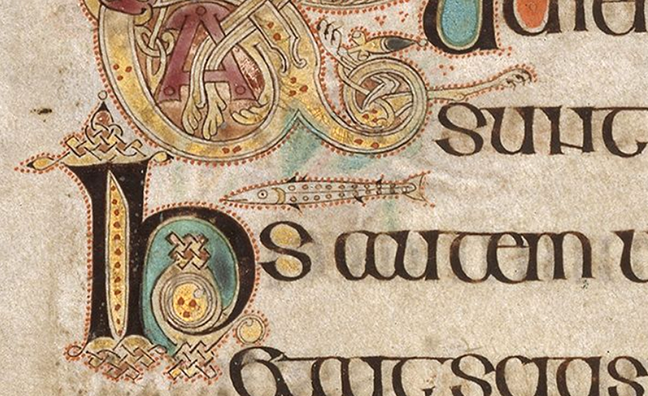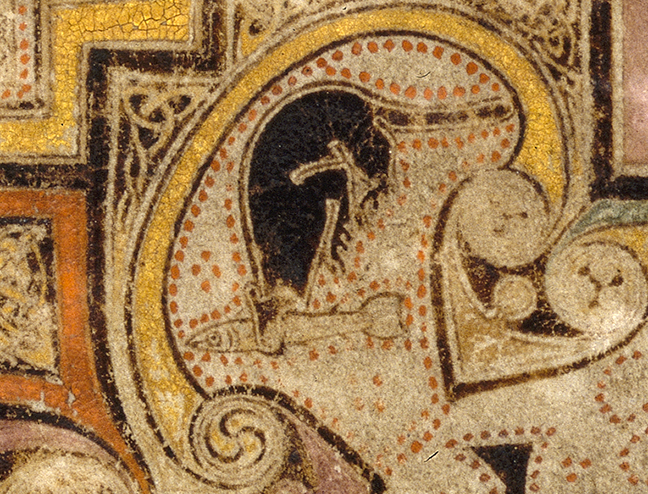Fish in the Book of Kells Next week: Modern meanings
Fish in the Book of Kells
182 comments
Dotted throughout the pages of the Book of Kells are relatively numerous images of fish.
The fish has been used as a Christian symbol as far back as the second century AD, when theologian, Clement, bishop of Alexandria (c. 150 – 215AD) recommended the suitability of the fish symbol as ‘if someone is fishing he will call to mind the apostle and the children [newly baptised Christians?] drawn up out of the water.’
Writing in the fourth-century, Augustine of Hippo (345 – 430) pointed out that fish also denoted the name of Christ, as the letters of the Greek word for fish, IXθYΣ, were an acronym for the words Jesus/Christ/Son of God/Saviour.
The fish depicted in the Book of Kells are more realistic in their portrayal than many of the fish in early Christian art, bearing resemblance to the salmon.
 Fig 1. A fish forms the cross bar of the letter F for Fuit fol. 188v. © The Board of Trinity College, University of Dublin.
Fig 1. A fish forms the cross bar of the letter F for Fuit fol. 188v. © The Board of Trinity College, University of Dublin.
During the early medieval period in Ireland, salmon was a prestige fish and there is some evidence to suggest that they were particularly associated with kings. They also feature in mythological material. For example, the hero Fionn mac Cumhaill gained his wisdom from the skin of the ‘salmon of knowledge’ on which he had burned his finger.
 Fig 2. The abbreviation of a word was signalled by a straight line above it. On fol. 89v, the letters IHS are an abbreviation of Jesus, indicated by the fish above. © The Board of Trinity College, University of Dublin.
Fig 2. The abbreviation of a word was signalled by a straight line above it. On fol. 89v, the letters IHS are an abbreviation of Jesus, indicated by the fish above. © The Board of Trinity College, University of Dublin.
The fish in the Book of Kells are deployed in various ways. Some form an integral part of letters, often shown biting another animal or act as an abbreviation mark over the name of Jesus Christ himself (179v) or drift between the lines of text. On fol. 34r, the Chi Rho page, a fish is shown being consumed by an otter. It is suggested that this symbolises the consumption of Christ’s body as part of the Eucharist.
 Fig 3. An otter consuming a fish on fol. 34r. © The Board of Trinity College, University of Dublin.
Fig 3. An otter consuming a fish on fol. 34r. © The Board of Trinity College, University of Dublin.
© Trinity College Dublin

© Mags Harnett
Well done for reaching the end of Week 3 of our course. We hope you have enjoyed the videos and articles about the meanings behind illustrations in the Book of Kells.
Remember, if you would like to access more resources about this course, refer to the databank in Week 1.
For the final week of the course, we will be exploring the use of the Book in modern times, including:
- Modern reproductions of the Book of Kells
- The Book of Kells as a modern Irish icon
- Exhibiting the Book of Kells in Trinity College
- The Book of Kells in literature, from classic James Joyce texts to Marvel comics
- Why the Book became a popular tourist attraction
We will be asking you to think about how you would curate the Book and sharing your thoughts with other learners.
Join us in Week 4!
© Trinity College Dublin

Postar um comentário